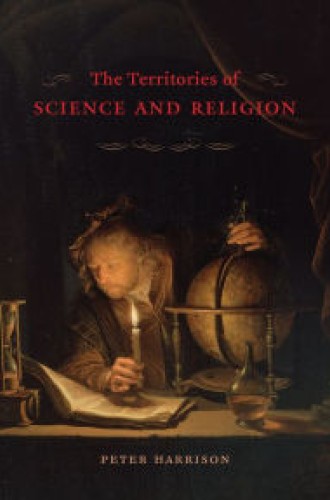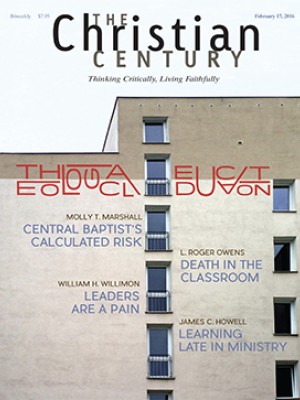The myth of a religion/science conflict
Throughout history, the tacitly understood relationship between religion and science could be described as follows: these two institutions—or worldviews or domains of life or lenses for interpreting the universe (take your pick)—are and always have been in conflict. The former reflects a primitive state of consciousness that in the past couple of centuries has succumbed to the accelerating victories of rationalism and empirical science. Churches and clerics have thus ceded long-standing cultural, intellectual, and political authority to science and technology and their concomitant institutions, supplanting the tyranny of the arbiters of faith with a modern, democratic regime of reasoned progress.
To which account we might be expected to reply, Amen.
Not so fast. According to Peter Harrison, every piece of this tacit narrative is false. Not just historically false, but conceptually false, and painfully so. In The Territories of Science and Religion, a provocative historical unpacking of the religion-versus-science debate, Harrison contends that the idea that there is something called religion and something else called science is a phenomenon of the recent past. Only since the 19th century or thereabouts have religion and science been separately identifiable. The narrative history proffered by those trumpeting the victory of scientific rationalism over superstitious faith is thus, in Harrison’s words, a conflict myth.
Read our latest issue or browse back issues.
This myth is resilient. It insinuates itself into scientific texts, popular histories, academic writing in various fields, and journalistic reporting. We find it on both sides of the supposed conflict: it appears in the triumphalist writings of the New Atheists and in the antireligious screeds of skeptical organizations within science and medicine, and we see it in the antiscience apologias of religious fundamentalists and in attacks that call reasoned bioethical judgments ungodly.
The presumed conflict between religion and science even takes on ironic tones: creationists try to co-opt biology by asserting that their own science is true and that the scientists’ science is not; and strident secularists issue dogmatic, authoritarian statements about their own worldview. Harrison has courageously undertaken the task of sorting through all this and making sense of it as he traces the discussion forward from antiquity.
A historian trained at the University of Queensland, Yale, and Oxford, Harrison directs the Centre for the History of European Discourses at Queensland, and he formerly held a named chair at Oxford and directed its Ian Ramsey Centre for Science and Religion. He has published extensively in history, philosophy, and religion. In 2011 he gave the Gifford Lectures at Edinburgh on the subject of this book.
Harrison’s thesis is simple. The modern terms science and religion evolved from the earlier scientia and religio, both virtues or intrinsic personal characteristics that ideally lead to particular mental dispositions: religio is a moral virtue akin to inner piety, and scientia is an intellectual virtue or habit of mind.
Since the Middle Ages these constructs have been removed from the moral realm and transformed into categorical sets of practices and beliefs defined by finite bodies of knowledge overseen by experts. Accordingly, religio and scientia were “turned inside out.” Modern-day science evolved from what was once known as natural philosophy, and modern-day religion from the circulating doctrinal statements within respective theological systems. Ironically, for Aquinas religio was a science, as the word might be used today, and for many others scientia was informed by theology. Now, centuries later, “evacuation of personal moral qualities” from scientia and the transformation of religion into a word denoting irrationalism and antiscientific superstition has produced the presupposition of eternal conflict.
If Harrison is correct, then the tacit narrative of historic conflict between religion and science must be a myth. Contemporary religion and science are cultural constructs of recent vintage that have not existed long enough to have experienced a history of conflict.
Harrison also cautions against an equally stubborn myth of cooperation, which is often put forth as an earnest corrective to the conflict myth. One sees this, for example, in the writings of New Age authors seeking to prove that the laws of physics are consonant with Eastern spirituality, or that ideas found in esoteric religion align with theories of alternative medicine. These consonances may exist, but that doesn’t mean science is inherently compatible with religion or spirituality. The contemporary concepts of religion and science have not existed long enough to have experienced a history of cooperation either.
By way of self-disclosure, I am neither a historian nor a philosopher; nor do I regularly contribute to the religion-and-science discussion. Rather, I am a working scientist, an epidemiologist to be precise, who has devoted over 30 years to researching the population-health impact of religious participation. Moreover, my faith background is Judaism, not Christianity, the context in which Territories was written. I therefore wonder whether the story Harrison tells is universal, or whether it is a function of particularities existing within Christian Europe throughout the past millennium.
This is by no means a criticism of this marvelous work of scholarship. And I suspect that what Harrison describes does have global application in regard to the evolution of modern religion and science. But I am not sure whether a conflict myth can be identified within, say, Jewish, Muslim, or Asian contexts.
Within Jewish tradition, for example, many of the great medieval rabbinic sages and Torah commentators were also physicians. Presently many of the most prominent Jewish physicians, bioethicists, and physical scientists are Orthodox and Torah-observant Jews—some of them rabbis. Throughout the post-Temple era the greatest rabbis and the greatest figures in science and medicine have often been the same men.
My own great-grandfather, Rabbi Judah Leib Levin, ordained at the Lithuanian yeshivot of Volozhin and Kovno in the 19th century, was a founder of Agudath ha-Rabbonim, the first organization for Haredi rabbis in North America. He also invented the combined adding and subtracting machine; I have seen the letter attesting to this from the Smithsonian Institution, in whose permanent collection the invention resides. My point: although it would not be accurate to assert that religion and science are blissfully cozy partners in contemporary Jewish (or Muslim or Asian) life and that they always have been, one would be hard pressed to identify there anything like the conflict myth Harrison describes for the Christian intellectual world.
Reading Territories makes me wish for intrepid scholars to apply Harrison’s approach to other conflict myths involving religion in its personal and institutional expressions. Religion and education, religion and medicine, religion in the public square, religion and moral development, and prosocial behavior—each begs for the Harrison treatment.
Territories is not an easy read, at least for this epidemiologist. Harrison fluently draws on evidence from history, philosophy, theology, and language, and the book reads like the work of a polymath. Reading it requires a slow and steady approach, with focused effort to mull over each sentence and footnote. I suspect that I lack the requisite background to zip through the text. But I assure prospective readers, especially nonacademics, that a careful reading will pay dividends. Your labors will be rewarded.
Harrison’s achievement is a corrective to decades of uncritical writing. It deserves to redirect scholarship on religion and science and to reset the tenor of the field for years to come.







